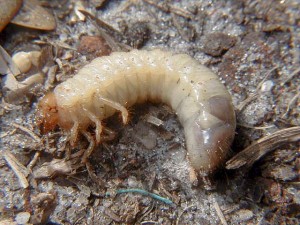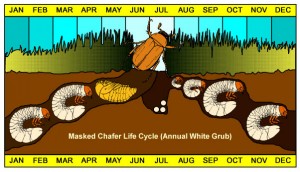Those pesky grubs can be very problematic in home lawns and understanding what type of damage they cause and when is the proper time to treat is imperative to successful control.
The term grub refers to a number of larval species of beetles that spend part of their life cycle in the soil. Among these species are Japanese beetles, May or June beetle, Masked chafer and a few others. As adults, they emerge from the ground in mid-summer where they are recognized as the aforementioned species. They mate, lay eggs in the ground and new larvae begin feeding on roots and organic matter in the soil. They overwinter and continue feeding underground the next spring. They emerge again in mid-summer and the cycle repeats.
Recognizing grub damage can be fairly easy. Turf may show initial signs of irregular brown patches and in severe cases is easily lifted and rolled away from soil due to the damage incurred by root feeding. Damage is usually most noticeable in August and September as grub damage and hot, dry conditions reveal damage.
To scout for grub populations, using a spade, lift back a portion of turf. If 6-10 grubs are present per square foot, treatment is required. Sample 10 areas in the yard and inspect all weak areas to see if grubs are present.
Initially, the best control option for grubs is a healthy, vigorous turf. Proper water, mowing, and fertilizer programs will limit grub damage. Certain turf species such as turf-type tall fescues may be able to tolerate higher grub populations because they have a deeper root system. Also important is management of the thatch layer. Regular aeration will help break up the thatch layer where grubs may inhabit as well as help insecticides reach their target when chemical control is needed.
If chemical control is needed, timing is critical. Since grubs are most effectively treated when small, it is important to time grub treatments in mid- summer after emerging from eggs. This is usually late June, July or early August depending on weather and other variables. Treatments made in the spring or late in the fall may fail because grubs are large and require certain doses or classes of insecticides to be effectively treated.
There are a variety of products on the market for grub control. Some common products are Merit, Mach2 and a plethora of others. These products usually last for a month or two after initial application. Again it is imperative to target the window when grubs are small for best results. A new product on the market called Acelepryn has an even greater effective period and can be applied in spring for biilbugs and other insects and is still active in summer for grub control. Another added benefit of Acelepryn is that it is extremely safe on the environment. Regardless of the product used, it is important to follow all manufacturers’ instructions regarding proper rates to make sure the right amount of product is used.
 All in all, by being able to recognize grub damage, knowing when to treat and what product to use, one can prevent grub damage and keep the lawn looking great.
All in all, by being able to recognize grub damage, knowing when to treat and what product to use, one can prevent grub damage and keep the lawn looking great.
